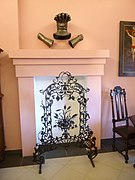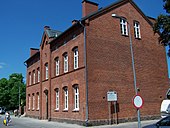History
The Regional Museum in Szczecinek dates to 1866 making it one of the oldest museums in Western Pomerania. The museum was created after an archaeological exhibition organized by Prussian major and cryptologist, Fryderyk Wilhelm Krasiski [5] at the armory building (auxiliary formations of the Prussian army) located at the Kosciuszko Street. [6] The exhibition consisted of objects found during excavations conducted by him, including the pile deposits discovered in Parsęca. Until 1881 (until Kasiski's death), the exhibition grew considerably and numbered 702 pieces. After his death the collection was sold and gave rise to the Ethnological Museum (germ. Ethnologisches Museum) in Berlin (Dahlem).
The museum was established half a century later when the historical interests were again enlivened by the ceremonial celebrations of the 600th anniversary of Szczecinek creation in 1910. In the autumn of 1913, mayor K. Sasse, established the Museum Society. The association members included well-known citizens of the city of Szczecinek: K. Tümpel, E. Wille, landrat (head of the county) Ernst von Hertzberg, and painter Paul Stubbe. Thanks to the association of the museum, the museum was established in June 1914, in the tower of St. Nicholas church (remains of the first Christian church in Szczecinek city). [7] The pre-war collection was small but valuable. The works that were exhibited at the time documented the history of the city and of the region. The collection included, among others, the silver goblets donated by princess Ann (from 1606), and princess Jadwiga (from 1625).
The activity of the facility, however, was halted by the outbreak of World War I. Thanks to the efforts of Georg Zehm in 1935, the museum was moved to the castle (Zamek Książąt Pomorskich) in Szczecinek. [8] At the end of World War II, in February 1945, after the city was taken over by the Soviet army, part of the collection was thrown out of the window. Some of these monuments were saved by the Sisters of the Immaculate Conception of the Blessed Virgin Mary. One of them, Maria Krysta, wrote the first post-war booklet devoted to the history of the city.
Restart of the museum in Szczecinek was taken on by Aleksander Stafiński and reverend Anatol Sałaga, who organized the Civic Committee of the Museum in Szczecinek and Szczecinek Land. In July 1947 the tower of St. Nicholas became a temporary headquarters of the museum [9]
In September 1957, the Presidium of the Municipal National Council in Szczecinek established a new Organizing Committee of the Museum. The organization of the museum was also supported by the Szczecinek branch of the Polish Historical Society. On February 28, 1958, during the celebration of the anniversary of the takeover of Szczecinek by the Soviet army, the Regional Museum of Szczecinek was opened. At that moment it was supposed to be located in the church tower of St. Nicholas, but later it was scheduled to be moved to the Castle of Dukes of Pomerania (Zamek Książąt Pomorskich) in Szczecinek. [10] Nevertheless, the exhibition remained at St. Nicholas church until 2006. [11]
Ultimately, thanks to the former mayor of the city, Marian Tomasz Goliński, the museum was moved to the 19th-century building of the former local school. [12] Thanks to the EU grant money, the Ministry of Culture and National Heritage, and the financing from the city of Szczecinek, the building had been adapted for museum purposes. The ceremonial inauguration took place in 2006. The new headquarters is several times bigger than the previous one and it is more functional. Presently a steady increase of the art collection in the museum is possible thanks to the support of mayor Jerzy Hardie-Douglas.
In the words of the Director of the Regional Museum in Szczecinek, Ireneusz Markanicz:
"The main focus of the Regional Museum in Szczecinek is to provide more information about the city architecture and circumstances of the settlers. I believe that these people are our outstanding heroes and thus the history makers. It is also important to remember the frontier roots of those who came here after 1945, since the modern inhabitants of Szczecinek are their descendants, and it is worthwhile to bring this culture closer to the next generations" [13]
In 2014 the Regional Museum in Szczecinek celebrated its 100th anniversary. [14]

Pomerania is a historical region on the southern shore of the Baltic Sea in Central Europe, split between Poland and Germany. The central and eastern part belongs to the West Pomeranian, Pomeranian and Kuyavian-Pomeranian voivodeships of Poland, while the western part belongs to the German states of Mecklenburg-Western Pomerania and Brandenburg.
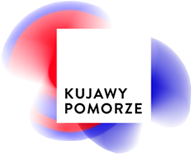
Kuyavian–Pomeranian Voivodeship is one of Poland's 16 voivodeships (provinces).

West Pomeranian Voivodeship is a voivodeship (province) in northwestern Poland. Its capital and largest city is Szczecin. Its area equals 22 892.48 km2, and in 2021, it was inhabited by 1,682,003 people.

Szczecinek is a historic city in Middle Pomerania, northwestern Poland, with a population of more than 40,000 (2011). Formerly in the Koszalin Voivodeship (1950–1998), it has been the capital of Szczecinek County in the West Pomeranian Voivodeship since 1999. It is an important railroad junction, located along the main Poznań - Kołobrzeg line, which crosses less important lines to Chojnice and Słupsk. The town's total area is 48.63 square kilometres.

Radomsko is a city in southern Poland with 44,700 inhabitants (2021). It is situated on the Radomka river in the Łódź Voivodeship. Located in the Sieradz Land, it is the county seat of Radomsko County.

The Royal Castle in Warsaw is a state museum and a national historical monument, which formerly served as the official royal residence of several Polish monarchs. The personal offices of the king and the administrative offices of the royal court were located in the Castle from the 16th century until the final partition of Poland in 1795. Situated in the Castle Square, at the entrance to the Old Town, the Royal Castle holds a significant collection of Polish and European art.

The Warsaw National Museum, also known as the National Museum in Warsaw, is a national museum in Warsaw, one of the largest museums in Poland and the largest in the capital. It comprises a rich collection of ancient art, counting about 11,000 pieces, an extensive gallery of Polish painting since the 16th century and a collection of foreign painting including some paintings from Adolf Hitler's private collection, ceded to the museum by the American authorities in post-war Germany. The museum is also home to numismatic collections, a gallery of applied arts and a department of oriental art, with the largest collection of Chinese art in Poland, comprising some 5,000 objects.
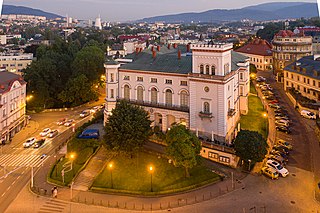
The Bielsko-Biała Museum, also known as the Castle of the Sułkowski Princes is a museum for the city of Bielsko-Biała, Poland located in the historical Bielsko Castle. Three local branches of the museum have been established since the 1970s: the Julian Fałat Museum, the Museum of Technology and Textile Industry, and the Weaver's House Museum.
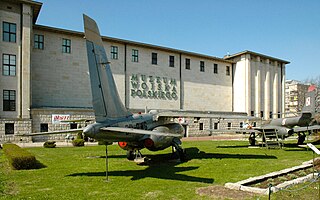
Museum of the Polish Army is a museum in Warsaw documenting the military history of Poland. Established in 1920 under the Second Polish Republic, it formerly occupied a wing of the building of the Polish National Museum and now occupies a building of its own at the Warsaw Citadel, as well as several branches in Poland. It is Warsaw's second largest museum and the largest collection of military objects in Poland. The collection illustrates a thousand years of Polish military history, from the 10th century to the Second World War.

The National Museum in Kraków, popularly abbreviated as MNK, is the largest museum in Poland, and the main branch of Poland's National Museum, which has several independent branches with permanent collections around the country. Established in 1879, the museum consists of 21 departments which are divided by art period: 11 galleries, 2 libraries, and 12 conservation workshops. It holds some 780,000 art objects, spanning from classical archeology to modern art, with special focus on Polish painting. In 2023, the museum was visited by over 1.65 million people, making it the third most-visited art museum in Poland and the 37th most-visited art museum in the world.
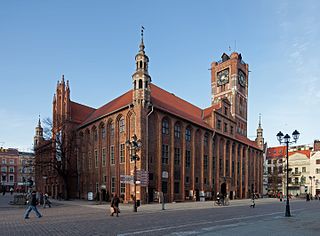
Toruń Regional Museum, located in the Ratusz hall of Toruń, is one of the oldest and largest museums in Poland. It started in 1594 as the mere Cabinet of Curiosities at the library of the academic Gimnazjum, called Musaeum in Latin. Re-established in sovereign Poland as a city museum in 1920 after the century of military partitions, it was administratively structured as the regional museum in 1965.
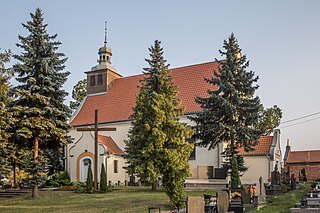
Górsk is a village in the administrative district of Gmina Zławieś Wielka, within Toruń County, Kuyavian-Pomeranian Voivodeship, in north-central Poland. It lies approximately 14 km (9 mi) west of Toruń and 30 km (19 mi) east of Bydgoszcz. It is located in Chełmno Land within the historic region of Pomerania.

Dorota Dziekiewicz-Pilich is a Polish sculptor and drawing artist.

Dzików Castle or Tarnowski Family Castle in Dzików is a 15th-century castle located in Tarnobrzeg, Poland. It is set in a park complex with gardens.

The National Museum in Wrocław, established 28 March 1947 and officially inaugurated on 11 July 1948, is one of Poland's main branches of the National Museum system. It holds one of the largest collections of contemporary art in the country.
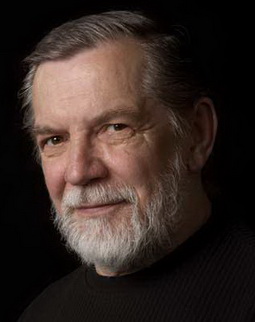
Emil Polit was a Polish painter known for his works on canvas and church murals. He was a portrait artist and painter of religious works which are exhibited in many churches in Poland and held in numerous collections including at the National Museum of Przemyśl, Art Exhibitions Bureau's Exhibition Center in Rzeszów, and at the Vatican.

Muzeum Sztuki, or the Museum of Art in Łódź, is a museum of modern and contemporary art in Łódź, Poland, whose main goal is to research and display the history of avant-garde art, with a focus on Central and Eastern Europe. Founded in 1931, Muzeum Sztuki became the first museum in Europe and the second museum in the world dedicated to collecting and showcasing modern art.

The Museum of Historical Costume in Poland is a private museum located in a tenement house on Kwiatowa Street 14/2 in Poznan, Poland. Founded in December, 2018 by Anna Moryto.

The Leon Wyczółkowski Regional Museum is an ensemble of cultural institutions which have been first created in 1923 in the city of Bydgoszcz, Poland.

Jerzy Hardie-Douglas is a politician and surgeon. He was a mayor of Szczecinek from 2006 to 2018, and again since 2024, and a member of the Sejm of Poland from 2018 to 2023.


